6.6 Foundations for Understanding Emotions
Enough sleep—wake up and face the challenges of the day! Midterm exams are just around the corner, your family is after you to get your life in order, your lover has just left you for another, and a hungry tiger is crouched behind you. Are you awake now? All these events have something in common: All (if you believe them) have the potential to elicit strong emotions.
Emotion, like motivation, is a concept that applies to almost all of psychology. Much, if not all, of our thought and behavior is tinged with emotion. Our goal in this section is to introduce you to some ideas about the underlying processes and mechanisms of emotion. You will find much more about particular emotions in other chapters.
The Nature and Value of Emotions
Emotion is a concept that has been difficult for psychologists to pin down and define in an agreed-upon way. According to one estimate, psychologists have generated at least 90 different definitions of emotion (Plutchik, 2001). Our own preferred definition is one that closely resembles the way the term is used in everyday life: An emotion is a subjective feeling that is mentally directed toward some object. That object can be another person (“She feels angry with John”), an object (“He fears snakes”), an idea or concept (“She loves freedom”), or even oneself, including pride, shame, guilt, shyness, jealousy, envy, empathy, and embarrassment. These latter emotions are called self-conscious emotions, all which seem to depend on an individual’s self-awareness (Draghi-Lorenz et al., 2001; Lewis, 1993). Some researchers refer to them as other-conscious emotions (Saarni et al., 2006) because they seem to be related to the expectations and opinions of other people for one’s behavior. These emotions, mature forms of which are not seen until late in the second year of life, seem to require a sophisticated cognitive system, one that may be unique to Homo sapiens. Moreover, such emotions are as much a characteristic of human nature as is our advanced cognition. As evolutionary primatologist Sarah Hrdy (1999) wrote: “What makes us humans rather that just apes is the capacity to combine intelligence with articulate empathy” (p. 392). Without “articulate empathy”—a sort of human glue that develops over time—sociability as we know it would not be possible, and we would be a very different species from the one we are today (if we existed at all).
232

37
According to the definitions used here, how does emotion differ from affect and from mood?
The feeling associated with emotion, independent of the object, is referred to by some psychologists as affect [aph-ect]. Such feelings can vary along two dimensions. One dimension has to do with the degree of pleasantness or unpleasantness of the feeling, and the other has to do with the degree of mental and physical arousal. Figure 6.14 shows one way of describing and depicting various affects. Notice that by moving upward or downward on the circle, one goes toward increasing or decreasing arousal; by moving rightward or leftward, one goes toward increasing degrees of pleasure or displeasure. The terms in the figure do not describe emotions, but rather feelings devoid of objects. An emotion depends on the object as well as the feeling. Thus, a feeling of pleasure may be experienced as the emotion of pride when the object is oneself and as the emotion of love when the object is someone else.
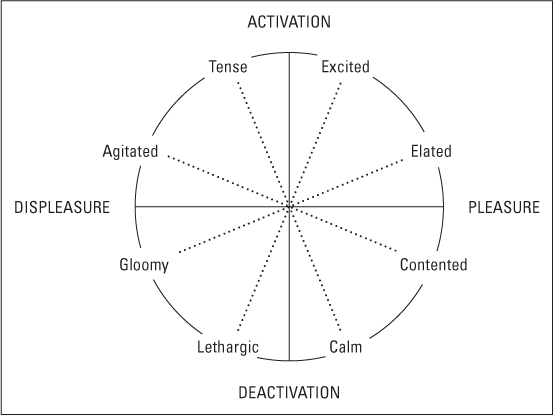
Emotional feelings are not always attached to objects. Sometimes an emotional feeling is experienced as free-floating rather than directed at a particular object, and in that case, if it lasts for a sufficiently long period, it is referred to as a mood. Moods can last for hours, days, or even longer and can color all aspects of one’s thought and behavior. In some cases, everyday language provides different terms for moods and emotions that have similar underlying feelings. A feeling of being tense, jittery, and unhappy may be labeled as anxiety when it is a free-floating mood but as fear when it is an emotion associated with an object such as a snake or an upcoming examination. A feeling of being sad and upset may be labeled depression when it is free-floating and as grief when it is associated with a specific loss.
Emotions have several components, beginning with a behavioral expression. An emotional response, such as a smile, does not always mean that the person is happy; just look at the smiling faces of actors whose names are not called for the Oscar (“And the Oscar goes to…”). A person may feel one emotion (disappointment upon receiving an ugly sweater for a Christmas present) but display another (joy, to the person who gave the gift). This reflects an ability to regulate emotions, something that develops over childhood and adolescence (Eisenberg & Spinard, 2004). Second, although facial expressions are perhaps the best way to read people’s emotions, we can also recognize other people’s emotions by their voice or their body language. We even do this with our pets, inferring that our dog’s rapidly wagging tail when given a treat is a sign of happiness (who’s to say it’s not?). Third, emotions are not independent of cognitions. In fact, the same physiological arousal may represent different emotions depending on how we interpret the situation. For example, a child’s increasing heart rate may reflect joy when she receives a jack-in-the-box for a gift; this same increase in heart rate may reflect fear, however, when the clown jumps out of the box and frightens her. As primatologist Robert Sapolsky commented, “based on heart rate measures one never can know for sure if it is a murder or an orgasm that has actually taken place” (quoted in Punset, 2005, p. 131). We’ll have more to say about emotions and cognition later in this chapter.
233
How Many Emotions Are There?
As you might imagine, the answer to this question is a bit arbitrary. It depends on how finely graded a taxonomy (system of classification) we wish to create. Fear, for example, might be understood as one emotion or as a cluster of emotions that all have some things in common. One’s fear of snakes, fear of death, and fear of others’ judgments, for example, may be experienced as qualitatively different from one another.

38
Through what strategy did Plutchik arrive at his model of eight primary emotions?
Some psychologists have attempted to identify a set of primary emotions by analyzing the emotion labels that are common to a language or to several languages. In English, several hundred different words are used as labels for emotions, but many of them are synonyms or near synonyms. By asking people to rate pairs of common emotion labels for the degree of similarity between the emotions they describe, psychologists have found that the labels can be clustered into a relatively small number of groups. One classification system that used this method that we think is useful was developed by Robert Plutchik (2003), who identified what he considers to be eight primary emotions. They can be arranged as four pairs of opposites: joy versus sorrow, anger versus fear, acceptance versus disgust, and surprise versus expectancy. According to Plutchik’s model (depicted and described more fully in Figure 6.15), these primary emotions can mix with one another in any number of ways to produce an essentially infinite variety of different emotional experiences, just as a small set of primary colors can mix to create virtually all the colors the human eye can see.

234
Emotions Serve Adaptive Functions
39
How can emotions promote adaptive ends through their motivating and communicative effects?
Emotions must have come about through natural selection because of their adaptive value. In fact, the first scientific theory and systematic study of emotions came from Charles Darwin, who in 1872 published his book The Expression of the Emotions in Man and Animals. Darwin proposed that emotions are universal and have species-specific adaptive functions, reflected by facial expressions. Darwin identified six basic emotions based on facial expressions—surprise, anger, sadness, disgust, fear, and happiness. (Compare this to Plutchik’s list of basic emotions.). He insisted that each conferred some adaptive benefit to the individual person or animal expressing them (see Conrad, 2004, and Fox & Stifter, 2005, for a more detailed discussion). The belief that basic emotions are innate and associated with distinctive bodily and facial reactions is referred to as discrete emotion theory (Izard, 1991; Tomkins, 1962) and is an extension of Darwin’s functionalist view.
This line of thinking draws attention to the motivating qualities of emotions. Implicit in the positive-negative dimension of emotional feelings is the idea that emotions motivate us to approach objects that can help us, and to avoid or repel objects that hinder us, in our efforts to survive and reproduce. When passionately in love, we behave in all sorts of ways, including ways that under other conditions would seem foolish, to get close to our beloved, a potential partner in reproduction. When fearful, we run away, or freeze, or try to look inconspicuous, or in other ways attempt to avoid the dangerous predator or enemy. When angry, we puff ourselves up, threaten, and sometimes even fight, in order to repulse or change the behavior of one who tries to harm us or who stands in the way of what we want or need. Strong emotions of all sorts focus our attention narrowly on the object of the emotion and lead us to ignore, for a time, other events and drives that would distract us from that object. Table 6.2 presents several possible adaptive goals and action tendencies associated with some emotions (Saarni et al., 2006).
Possible adaptive goals and action tendencies associated with some emotions
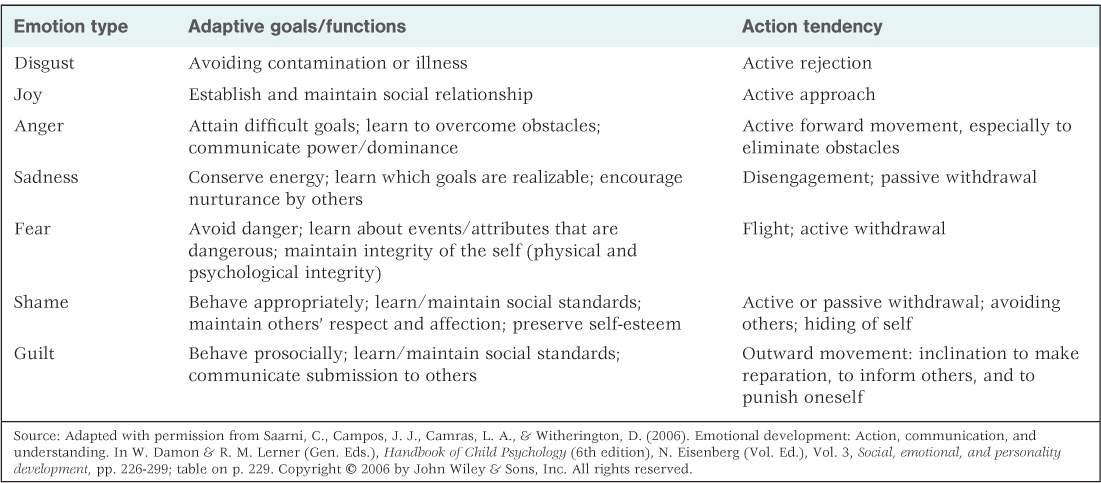
235

Emotions also promote our survival and reproduction through their capacity to communicate our intentions and needs to others. Our expressions of love may signal to our beloved that we will be faithful mates. Our expressions of fear may signal submission to our human attackers and thereby prevent a fight, or they may draw friends to our aid. Mere hints of anger in our demeanor may, all by themselves, convince the objects of our anger to change their ways in desired directions. As discussed in Chapter 3, many emotions are automatically and unconsciously expressed on the face in ways that are universal. Such expressions most likely came about through natural selection primarily because of their communicative value.
Self-conscious emotions such as pride, shame, guilt, jealousy, and embarrassment are of critical importance for successful social life. Nearly all social interactions involve emotion. Our social situations affect our emotions, and our emotions affect our behavior. As social beings, we are endowed with emotions that help us to keep connected with others, to coordinate our behavior with that of others, to gain and retain social acceptance, and, at the same time, to avoid being exploited by others. The feelings of guilt, shame, and embarrassment are painful, and the pain may motivate us to make amends when we have offended others or been ineffective in some way. Conversely, the feeling of pride rewards us for behaving effectively and gaining others’ approval.
Facial expressions of at least some emotions may serve more than communicative value; they may be part of the body’s way of dealing with the emotion-arousing situation. The expression of fear, for example, involves a widening of the eyes and an opening of the nasal passages, which increases the field of vision and increases sensitivity to odors (see Figure 6.16a). In a fear-provoking environment, such increased sensitivity to sights and smells may have been useful to our evolutionary ancestors, and may still be useful, as a means of detecting potential threats (Susskind et al., 2008). Conversely, in the emotion of disgust—which involves a rejection of some object in the environment—the field of vision and the nasal passages narrow, cutting off the offending sight or odor (see Figure 6.16b).
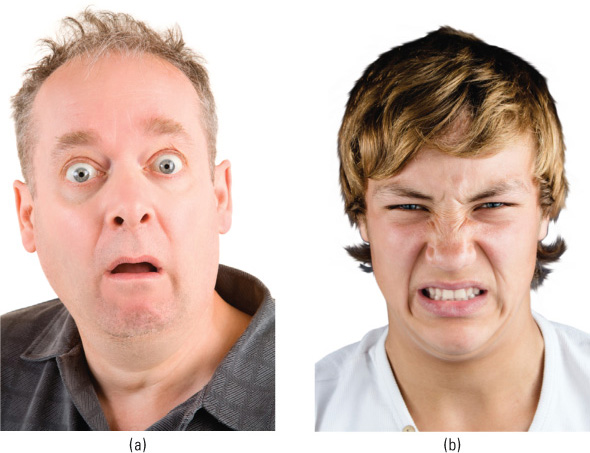
themacx/iStockphoto/Thinkstock
Effects of Bodily Responses on Emotional Feelings
Most emotional states are accompanied by peripheral changes in the body. By peripheral changes, we mean all changes in the body outside of the central nervous system. These include changes in heart rate, blood pressure, diversion of blood from one set of tissues to another, activation of certain glands, tension in particular muscles, and facial expression of the emotion. The changes, overall, are adaptive because of their communicative function or their role in helping prepare the body for possible action.
Common sense and everyday language tell us that these peripheral changes are caused by our emotions. We say: “My heart pounds and I tremble because I am afraid”; “My face is flushed and my teeth are clenched because I am angry”; “Tears well up in my eyes and a lump forms in my throat because I feel grief.” Over 100 years ago, in his classic textbook The Principles of Psychology, William James (1890/1950) turned common sense upside down and suggested that bodily reactions precede the emotions and cause them, rather than the reverse.
236
James’s Peripheral Feedback Theory of Emotion
40
What is James’s theory of emotion? What evidence did James supply for the theory, and what modern evidence is consistent with the theory?
James’s evidence for his theory of emotion came not from experiments but from introspection. Looking inward at his own emotions, James concluded that his emotional feelings were really sensations stemming from bodily changes. Thus, his feeling of fear was elicited by a quickened heart, shallow breathing, goose-flesh, and trembling limbs. Similarly, his feeling of anger was elicited by a flushed face, dilated nostrils, and clenched teeth. James believed that he could identify a different constellation of bodily changes for each emotion and that if he could not feel these changes, he would not feel the emotion.
The essence of James’s theory is that the bodily reaction to an emotion-provoking stimulus is automatic, occurring without conscious thought or feeling, and that the assessment of one’s emotional state comes later and is based on the perception of the bodily state. In an unexpected encounter with a bear, the brain instantly, at some unconscious level, judges the bear to be dangerous and precipitates a bodily change that helps prepare the person for flight. There is no time, in an emergency, for conscious reflection. The body reacts immediately. Then, later on, when the danger is over or at least reduced, the person may sense his beating heart and trembling knees and conclude that he is or was frightened. The contrast between James’s theory and the commonsense theory that he was arguing against is illustrated in the top two portions of Figure 6.17.
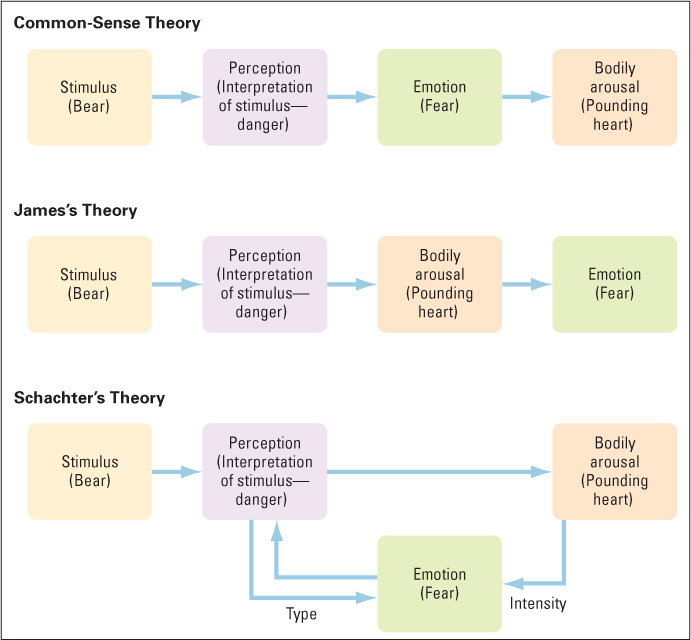
A considerable amount of evidence today tends to support James’s theory. People throughout the world describe their emotions in terms of bodily changes and are quite consistent in the kinds of changes they associate with each emotion (Cacioppo et al., 1992; Rime et al., 1990). Researchers have also found that people who are particularly good at detecting changes in their own internal condition, such as changes in their heart rate, are more likely than others to detect and report emotional states in themselves (Critchely et al., 2004; Wiens et al., 2000). Moreover, brain imaging studies have shown that a certain portion of the somatosensory area of the cerebral cortex, which becomes active when a person is sensing his or her own bodily state, also becomes active when a person is consciously assessing his or her own emotional state (Critchely et al., 2004; Damasio, 2001).
237
Schachter’s Cognition-Plus-Feedback Theory
41
How does Schachter’s theory differ from James’s? How did Schachter support his theory with experiments?
In the 1960s, Stanley Schachter developed a theory of emotion that can be understood as a variation of James’s theory. According to Schachter, the feeling of an emotion depends not just on sensory feedback pertaining to the body’s response but also on the person’s perceptions and thoughts (cognitions) about the environmental event that presumably evoked that response. More specifically, he proposed that perception and thought about the environment influence the type of emotion felt, and that sensory feedback about the degree of bodily arousal influences the intensity of the emotion felt (see the bottom portion of Figure 6.17). Thus, if you see a bear, your perception that it is dangerous leads you to interpret your emotion as fear, and your perception of the degree to which your heart is pounding and your knees are trembling determines the amount of fear you experience. Schachter also proposed that the intensity of the emotional feeling influences the interpretation of the stimulus. Thus, if your bodily arousal was already high, perhaps from drinking too much coffee, that arousal would contribute to your emotional intensity and might lead you to perceive the bear as more dangerous than you would otherwise perceive it to be.
In experiments testing his theory, Schachter (1971) injected people with either epinephrine (a hormone also known as adrenaline, which raises heart rate and produces other effects associated with high arousal) or a placebo (an inactive substance) and then exposed them to various emotion-eliciting conditions. He found that epinephrine by itself did not produce any particular emotion (the subjects just said they felt jumpy), but when epinephrine was combined with an emotion-inducing situation, such as a horror film, it increased the intensity of the subject’s emotion. As predicted by his theory, the kind of emotion subjects felt depended on the external situation, but the intensity was heightened by epinephrine. The epinephrine-injected subjects manifested and reported more anger when insulted, more fear when watching a frightening film, and more hilarity when watching a slapstick comedy than did placebo-injected subjects. This emotion-enhancing effect occurred only if the subjects had not previously been informed of the physiological effects of epinephrine. Thus, according to Schachter, high physiological arousal increases emotion only when people believe that the arousal is caused by the external situation. Schachter’s theory fits well with the modern idea that emotions are defined not just by feelings but also by the perceived objects of those feelings.
Influence of Facial Feedback on Emotional Experience
In the 1980s Paul Ekman (1984) proposed a theory of emotions that is similar to James’s peripheral feedback theory but focuses particularly on the role of the face. As discussed in Chapter 3, Ekman and his colleagues found that different basic emotions are associated with different facial expressions. Those expressions are produced rapidly and automatically (though they can be inhibited). According to Ekman, sensory feedback from facial expressions contributes both to emotional feelings and to the production of the full-body reactions that accompany emotions.
238
42
What is some evidence supporting Ekman’s theory that a person’s facial response influences the person’s feeling of an emotion and also influences the person’s bodily responses to the emotional situation?
If you form your face into a smile, will you feel happier? A suggestion typical of the literary heroine Pollyanna, perhaps—but research indicates that there may be some truth to it. In one experiment, for example, some subjects were each asked to hold a pencil tightly between their teeth, which forced their faces into smiling expressions, and others were asked to hold a pencil between their lips in a manner that did not produce smiles (see Figure 6.18), as they watched films of happy or funny scenes (Soussignan, 2002). The result was that the former reported more enjoyment of the films than did the latter. In other experiments, subjects have been asked to contract certain facial muscles—in ways (unbeknownst to the subject) designed to mimic the facial expressions of fear, anger, sorrow, or happiness. The results, generally, are that people who hold their faces in these ways subsequently report experiencing more of the specific emotion that their faces were mimicking—whether or not they were aware that they were mimicking a particular emotion (Flack, 2006).

Ekman and his colleagues (1983) found that induced facial expressions not only can alter self-reports of emotion but also can produce physiological responses throughout the body that are consistent with the induced expression. In one experiment, these researchers asked subjects to move specific facial muscles in ways designed to mimic each of six basic emotional expressions (see Figure 6.19). For comparison, they asked other subjects to experience each emotion by mentally reliving an event in which that emotion had been strong. As the subjects held the facial expressions or imagined the emotional events, various indices of their physiological arousal were recorded.
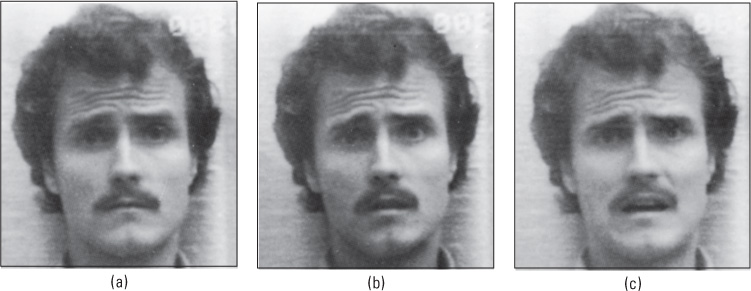
The main finding was that different patterns of arousal accompanied different emotions, but the pattern for a given emotion was the same whether the person had been asked to relive that emotion or simply to move certain facial muscles. For instance, anger, whether it was relived or mimicked by facial molding, was accompanied by increases in skin temperature that did not occur for the other emotions (consistent with evidence that blood tends to flow into the skin during anger).
239
As another example, both anger and fear—in both the mimicking and the reliving conditions—increased the subjects’ heart rates more than did any other emotion. Researchers subsequently replicated these findings with a wide variety of people, including people in non-Western cultures (Levenson, 1992; Levenson et al., 1992).
Brain Mechanisms of Emotion
Thus far, we have focused on emotional feelings and peripheral bodily changes and have said little about the role of the brain in emotions. But of course the brain is the center both for producing the bodily changes and for experiencing emotional feelings. Research on the brain’s emotional systems has focused particularly on two structures: the amygdala and the prefrontal portion of the cerebral cortex.
The Amygdala Assesses the Emotional Significance of Stimuli
In James’s classic example (diagrammed in Figure 6.17, p. 236), a person sees a bear and reacts in a manner that the person subsequently interprets as fear. What causes the initial reaction? James assumed that somehow the brain can quickly and unconsciously assess the significance of stimuli and can generate appropriate bodily reactions. We now know that a crucial structure for this capacity of the brain is the amygdala.
Recall from Chapter 5 that the amygdala, a cluster of nuclei buried underneath the cerebral cortex, in the temporal lobe, is part of the limbic system. This structure appears to be, among other things, the brain’s early warning system. It receives stimulus input from all of the body’s sensory systems; performs continuous, rapid assessments of that input; and alerts the rest of the brain and body if it judges that some sort of whole-body or behavioral reaction may be called for.
The amygdala receives sensory input by way of two routes: a very rapid subcortical route and a somewhat slower cortical route (diagrammed in Figure 6.20 for the sense of vision). Through the former, it analyzes incoming information even before that information has been processed by sensory areas of the cerebral cortex. Through the latter, it analyzes, in more detail, information that has been processed by the cerebral cortex. The amygdala sends its output to many other brain structures. Through those outputs it alerts the rest of the brain to pay attention to the stimulus of concern, and it generates such bodily reactions as increased heart rate and muscle tension (Davis, 1992).
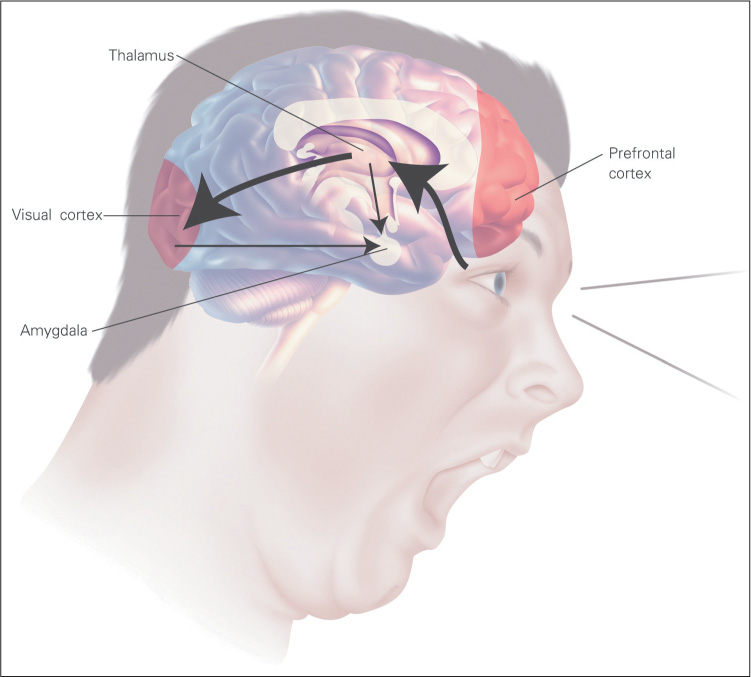
240
43
What is some evidence that the amygdala initiates emotional reactions to stimuli and that this effect can occur even without conscious awareness of the emotion-eliciting stimuli?
In a set of classic experiments with monkeys, removal of the amygdala along with nearby portions of the temporal lobe of the cerebral cortex on both sides of the brain produced a dramatic set of changes in behavior described as psychic blindness (Klüver & Bucy, 1937; Weiskrantz, 1956). The monkeys could still see objects and could move in a coordinated fashion, but they seemed indifferent to the psychological significance of objects. They no longer responded fearfully to objects that had previously frightened them or aggressively to objects that had previously angered them. They also failed to distinguish in the usual ways between foods and nonfoods or between appropriate and inappropriate objects for sexual attention.
Humans who have suffered even partial damage to the amygdala exhibit striking losses in fear and anger, even though they don’t show the other symptoms of psychic blindness (Allman & Brothers, 1994; Berridge, 2003). For instance, one woman with such damage failed to react emotionally, or even to show much concern, when she and her husband were mugged (Bruce & Young, 1998). In experiments, people with damage to the amygdala generally fail to respond emotionally to stimuli—such as pictures of frightening or disgusting scenes—that regularly elicit emotional responses and feelings in people with intact brains (Berntson et al., 2007; Helmuth, 2003). Moreover, in brain-imaging studies with people with intact brains, increased neural activity in the amygdala correlates strongly with increases in fear, anger, or disgust (Hamann et al., 2002; Whalen, 1998). The amygdala may also be activated, but less so, by stimuli that induce positive emotions, and may be more generally involved in processing the relevance of stimuli, both positive and negative (Cunningham & Borsch, 2012). In one brain-imaging study with men, the left amygdala (but not the right) became active in response to a variety of appealing pictures, including depictions of attractive seminude women and of appetizing foods (Hamann et al., 2002).
Researchers have found that people even react emotionally to stimuli—such as angry words or faces—that are flashed on a screen too rapidly for conscious perception (Öhmann, 1999; Ruys & Stapel, 2008). This effect most likely occurs by way of the subcortical sensory input to the amygdala. Joseph LeDoux and his colleagues found that rats with lesions destroying the entire visual and auditory cortex, but not the amygdala, continued to respond emotionally to sights and sounds that had previously been paired with electric shock, but rats with lesions destroying the amygdala did not (LeDoux, 1996; LeDoux et al., 1989). Similarly, people who have damage to the visual cortex have been shown to respond emotionally to visual stimuli that they could not consciously see (Anders et al., 2004). Sensory areas of the cortex are essential for conscious perception of stimuli, but not for unconscious emotional responses to them. The fact that emotional responses can be generated by subcortical pathways to the amygdala helps explain why our emotions are often irrational and so difficult to control through conscious reasoning.
The Prefrontal Cortex Is Essential for Conscious Experience of Emotion
241
44
What is some evidence that the prefrontal cortex is involved in the conscious feeling of emotions and that the right and left prefrontal cortices are differentially involved with different types of emotional responses?
While the amygdala is essential for unconscious emotional responses, the prefrontal cortex—that is, the foremost portion of the frontal lobe of the cerebral cortex (at right in Figure 6.20)—is essential for the full conscious experience of emotions and the ability to act in deliberate, planned ways based on those feelings. One line of evidence for this comes from observations many decades ago of people who were subjected to prefrontal lobotomy—an operation that disconnects the prefrontal area from the rest of the brain and was, before the development of drug treatments, a relatively common treatment for severe mental disorders. The operation usually relieved people of their crippling emotional feelings, but it also left them unable to plan and organize their lives effectively (Valenstein, 1986). The prefrontal cortex receives input from the amygdala and from the somatosensory cortex, and such input provides it with information about the amygdala’s assessment of the stimulus and the body’s state of arousal.
A good deal of research suggests that, to some degree at least, the two cortical hemispheres are involved in processing different emotions. Much research using EEG or fMRI has shown greater neural activity in the right prefrontal cortex when experiencing negative emotions (especially fear and disgust) and greater activity in the left prefrontal cortex when experiencing positive emotions (Haller et al., 1998; Davidson et al., 2003). Recent studies, however, suggest that this laterality of neural activity has more to do with neural preparation to respond to the emotional stimuli than with actual experience of the emotional feeling (Harmon-Jones et al., 2006; Maxwell & Davidson, 2007). The right prefrontal cortex seems to be most involved in responses that entail withdrawal, or moving away from the emotional stimulus. That is why the right prefrontal cortex is most responsive in the emotions of fear and disgust. The left prefrontal cortex seems to be most involved in responses that involve approach, or moving toward the emotional stimulus, which is why it is most responsive in happy emotions. The most telling data come from studies involving anger. Anger is a negative emotion, but it tends to evoke approach (to confront or fight) rather than withdrawal. Researchers have found that anger is generally associated with greater activation of the left prefrontal cortex than the right, especially if the subjects are given instructions that lead them to visualize possible responses to the anger-provoking stimulus (Harmon-Jones et al., 2006).
Such research on the brain and emotions illustrates nicely the increasing conjoining of psychological theories with knowledge of physiological mechanisms. Conscious and unconscious assessments of differing emotion-provoking stimuli, and anticipated responses to those stimuli, differ not just in the realm of subjective experience but also in the brain pathways that underlie those assessments and response preparations.
SECTION REVIEW
Emotions are subjective feelings directed toward specific objects.
Nature of Emotion
- An emotion is a feeling that is tied subjectively to an object of that feeling, as exemplified by anger at someone who insulted you.
- The feeling aspect of emotion, called affect, can vary in degree of arousal and degree of pleasantness or unpleasantness.
- Psychologists have theories, but no consensus, about how to classify emotions.
- Emotions have adaptive value, motivating us and communicating our intentions and needs to others.
Peripheral Feedback
- James argued that peripheral bodily reactions precede and cause emotions.
- Schachter proposed that peripheral feedback affects emotional intensity, but perceptions and thoughts determine the type of emotion.
- Ekman suggested that feedback from facial muscles can induce feelings and bodily reactions indicative of emotion.
- There is evidence to support all three of these ideas.
Brain Mechanisms
- The amygdala rapidly evaluates sensory information for its significance to survival or well-being and triggers bodily responses.
- The prefrontal cortex is crucial for conscious emotional experience and deliberate action based on it.
- The right and left prefrontal cortices are relatively specialized for emotional responses involving, respectively, withdrawal and approach.